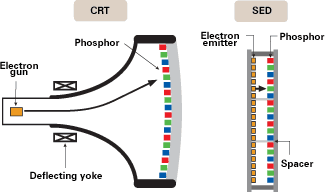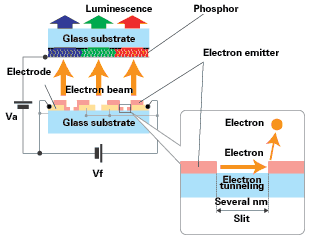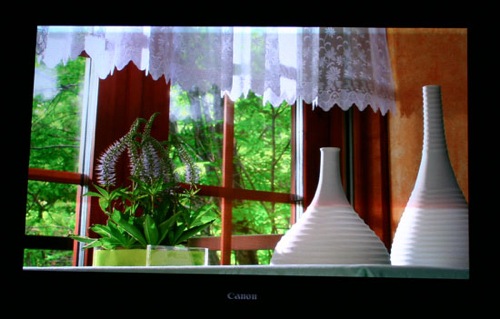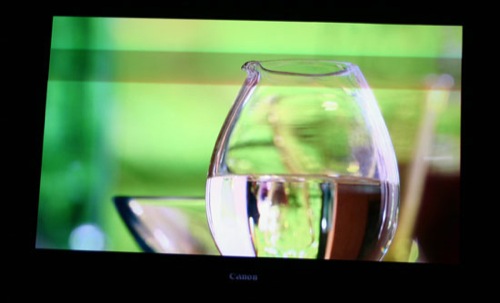CES 2006 - Day 3: Playstation 3, Quarter-size Hard Drives, SED and lots of TVs
by Anand Lal Shimpi & Manveer Wasson on January 9, 2006 1:25 AM EST- Posted in
- Trade Shows
Canon and Toshiba Demonstrate SED TVs
Canon and Toshiba have been working on yet another display technology called SED (Surface-conduction Electron-emitter Display). The goal of SED is to bring some of the good qualities of CRT displays (response time, brightness, black levels) to a fixed pixel, very thin, low power display.
The technology works very similarly to older CRT displays, except on a much smaller scale. In a CRT display a Cathode Ray Tube (CRT) would shoot electrons at phosphors behind the viewing glass to effectively paint the picture you see on your monitor. In a SED display, individual electron emitters shoot electrons on phosphors behind the viewing screen to create the pixels on your screen.

CRT vs. SED - provided by Canon Technology

How SED Works - provided by Canon Technology
Since a large CRT isn't necessary, SED TVs can be several centimeters thick rather than tens of inches. But with the response time, brightness, color reproduction and black levels comparable to CRT displays, SED technology has the potential to be the best of both worlds.
Like LCD and DLP technologies, SED displays are fixed pixel displays and there are three electron emitters per pixel. The downside to a fixed pixel display of course is that you end up sacrificing quality if you display content isn't at the same resolution as the native resolution of your display. In other words, there should be a 1:1 mapping of content pixels to each group of RGB electron emitters to obtain the absolute best image quality. However, as hardware scalers become more and more powerful the 1:1 pixel mapping problem becomes less important.
About six years ago Canon and Toshiba started working on developing SED technology for consumer TVs, and they are supposed to start shipping the first SED panels later this year. At the show both companies had demos of SED TVs (they looked to be around 30" diagonally). The conditions weren't perfect to truly evaluate the technology since they were in extremely dark rooms and with no other displays available for direct comparison. That being said, the image produced looked very nice. With no other types of TVs in the room we can't really say how it compared to LCD or Plasma TVs (SED's closest competitors), but it did look very good.

One thing we did notice was that the displays looked like they had extremely low refresh rates. You could see the screen refreshing much like a CRT set to 60Hz. Granted the technology is still pre-production so that could explain the issue.

The dark bar across the screen is our camera capturing the visible refresh rate on the display










45 Comments
View All Comments
quanta - Friday, January 13, 2006 - link
From page 8:Actually, that only exist if at least 1 dimension of display content dimensions isn't integer divisor of display's native resolution. Secondly, DLP can overcome this by shining at only the biggest subset of mirror in the DMDs that do not cause distortions, then use adjustable sets of lenses to perform zooming, with each set zooming at only 1 axis.
Kensei - Monday, January 9, 2006 - link
Please do a review of this thing when it becomes available. I'd love to see how its output compares to Blu-ray and HD-DVD. I'm sure it's not as good... but just how much worse is what I'd like to know.highlandsun - Thursday, January 12, 2006 - link
Samsung has pretty good scaling technology, but it seems to me this is something you only need in your display. (And Samsung TVs do pretty good upconversion already.) So, kind of silly.VooDooAddict - Monday, January 9, 2006 - link
Raptor X.I feel so guilty. I'm drooling over a hard drive that costs more then a 7800GT.
I've wanted a windowed Hard drive for ages though... but don't have the dremmel skills nessesary to add a window to an existing drive.
Questar - Monday, January 9, 2006 - link
Nobody has the dremel skills. Drives are assembled in clean rooms. Beaking the seal will be the end of a drive.Clauzii - Monday, January 9, 2006 - link
I´ve seen a drive approx. a year ago on the net - modded with blue light - woring - 20Gig. Damn where was it....?Clauzii - Monday, January 9, 2006 - link
But also found this .. it´s nothing new .......Clauzii - Monday, January 9, 2006 - link
This: http://www.halfbakery.com/idea/Transparent_20disk_...">http://www.halfbakery.com/idea/Transparent_20disk_...Clauzii - Monday, January 9, 2006 - link
woring = working...Eris23007 - Monday, January 9, 2006 - link
I've noticed lately that article text seems to disappear a few seconds after page load, frequently when one of the sidebar ads appears. Can't be retrieved except by highlighting it, moving the page back and forth (so it redraws), etc. Happened on a number of articles over the past week or so...
IE6/XP-SP2